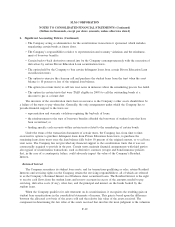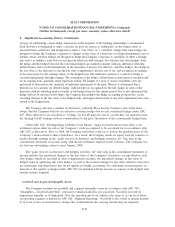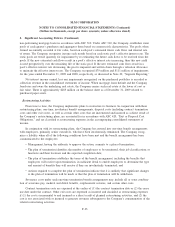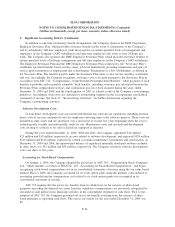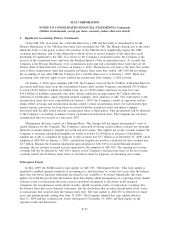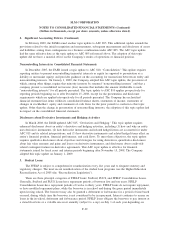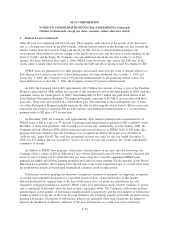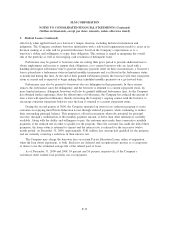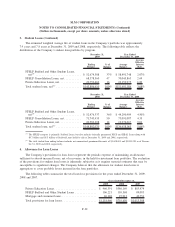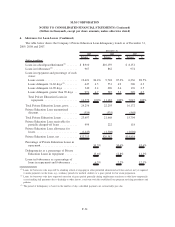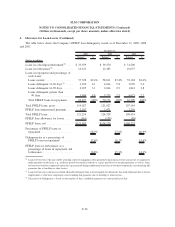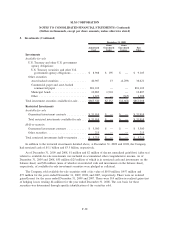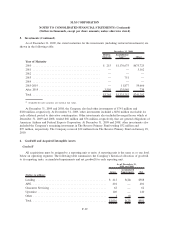Sallie Mae 2009 Annual Report Download - page 156
Download and view the complete annual report
Please find page 156 of the 2009 Sallie Mae annual report below. You can navigate through the pages in the report by either clicking on the pages listed below, or by using the keyword search tool below to find specific information within the annual report.2. Significant Accounting Policies (Continued)
In February 2009, the FASB issued another topic update to ASC 805. This additional update amends the
provisions related to the initial recognition and measurement, subsequent measurement and disclosure of assets
and liabilities arising from contingencies in a business combination under ASC 805. The ASC topic update
had the same effective date as the topic update to ASC 805 referenced above. The adoption of this topic
update did not have a material effect on the Company’s results of operations or financial position.
Noncontrolling Interests in Consolidated Financial Statements
In December 2007, the FASB issued a topic update to ASC 810, “Consolidation.” This update requires
reporting entities to present noncontrolling (minority) interests as equity (as opposed to presentation as a
liability or mezzanine equity) and provides guidance on the accounting for transactions between an entity and
noncontrolling interests. On January 1, 2009, the Company adopted this ASC topic update, the provisions of
which, among other things, require that minority interests be renamed “noncontrolling interests” and that a
company present a consolidated net income (loss) measure that includes the amount attributable to such
“noncontrolling interests” for all periods presented. The topic update to ASC 810 applies prospectively for
reporting periods beginning on or after December 15, 2008, except for the presentation and disclosure
requirements which are applied retrospectively for all periods presented. The Company has reclassified
financial statement line items within its consolidated balance sheets, statements of income, statements of
changes in stockholders’ equity and statements of cash flows for the prior periods to conform to this topic
update. Other than the change in presentation of noncontrolling interests, the adoption of this topic update had
no impact on the consolidated financial statements.
Disclosures about Derivative Investments and Hedging Activities
In March 2008, the FASB updated ASC 815, “Derivatives and Hedging.” This topic update requires
enhanced disclosures about an entity’s derivative and hedging activities, including (1) how and why an entity
uses derivative instruments, (2) how derivative instruments and related hedged items are accounted for under
ASC 815 and its related interpretations, and (3) how derivative instruments and related hedged items affect an
entity’s financial position, financial performance, and cash flows. To meet those objectives, the topic update
requires qualitative disclosures about objectives and strategies for using derivatives, quantitative disclosures
about fair value amounts and gains and losses on derivative instruments, and disclosures about credit-risk-
related contingent features in derivative agreements. This ASC topic update is effective for financial
statements issued for fiscal years and interim periods beginning after November 15, 2008. The Company
adopted this topic update on January 1, 2009.
3. Student Loans
The FFELP is subject to comprehensive reauthorization every five years and to frequent statutory and
regulatory changes. The most recent reauthorization of the student loan programs was the Higher Education
Reconciliation Act of 2005 (the “Reconciliation Legislation”).
There are three principal categories of FFELP loans: Stafford, PLUS, and FFELP Consolidation Loans.
Generally, Stafford and PLUS Loans have repayment periods of between five and ten years. FFELP
Consolidation Loans have repayment periods of twelve to thirty years. FFELP loans do not require repayment,
or have modified repayment plans, while the borrower is in-school and during the grace period immediately
upon leaving school. The borrower may also be granted a deferment or forbearance for a period of time based
on need, during which time the borrower is not considered to be in repayment. Interest continues to accrue on
loans in the in-school, deferment and forbearance period. FFELP loans obligate the borrower to pay interest at
a stated fixed rate or a variable rate reset annually (subject to a cap) on July 1 of each year depending on
F-29
SLM CORPORATION
NOTES TO CONSOLIDATED FINANCIAL STATEMENTS (Continued)
(Dollars in thousands, except per share amounts, unless otherwise stated)


